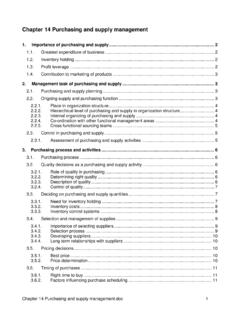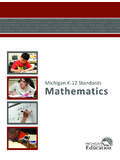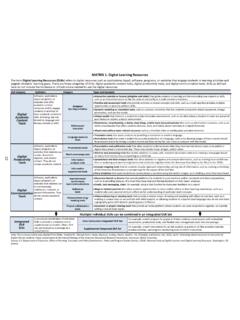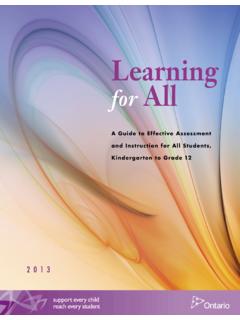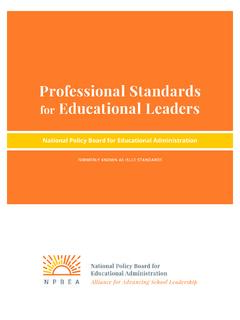Transcription of Principles of assessment - gimmenotes
1 V. Odendaal Notes: EDAHOD5 June 2018 STUDENT NOTES - NOT OFFICIAL 1 / 44 Principles of assessment *Fairness The method of assessment should not present any barriers to learners' achievements. It must be free of bias and sensitive to contextual factors. assessment must be bias-free and sensitive to gender, race, cultural background, abilities. Must be communicated clearly, accurately, meaningfully, timely. * Refer to the way learners are treated before, during and after the method is applied by you, the assessor. *Reliability The assessment must produce the same results when judged by more than one teacher or when the evidence is judged over a number of occasions. The results received from a test/ assessment must be consistent. Reliable assessment also means that when the assessment is developed, the input processes are well organised and are based on sound theoretical and educational measurement Principles .
2 *Validity The assessment is relevant to the standard set according to the CAPS for a specific assessment task. Method and techniques - appropriate to the knowledge, skills, attributes to be assessed, to the learner's age and level of development, suitable to the learner's specific context. The extent to which the assessment measures what it purports to measure. The purpose of assessment made explicit and a criterion-referenced approach is used. Validity can be improved by: - Carefully match the assessment with learning objectives, content and teaching methods - increase the sample of objectives and content areas included in any given assessment - use assessment methods that are appropriate for the objectives specified - employ a range of assessment methods - ensure adequate security and supervision to avoid cheating in examinations - improving the reliability of the assessment Sufficiency Sufficient assessment in the context of IP/SP would mean that the types of questions asked and the spread of content definition cover aspects of the work done during the term or year, as stipulated in the CAPS.
3 There must be enough evidence for the teacher to infer that the learner is either competent or not yet competent. *Refer to the amount of evidence learners have to generate to allow you to be able to make sound judgements and evaluations of learner performances and achievements. Currency The assessment must be present and related to what the learner knows or can do at the time of assessment . Refer to the time spent between gathering and evaluating the evidence in an assessment . *Authenticity Evidence is attributable to the candidate being assessed. The assessment is realistic and relevant and involves learner performance in real-world situations or simulations thereof. V. Odendaal Notes: EDAHOD5 June 2018 STUDENT NOTES - NOT OFFICIAL 2 / 44 Method / Activities Appropriate - suitable to the outcome being assessed Fair - does not present barriers to achieve outcomes Manageable - easily arranged, cost effective, does not interfere with learning Integrated into work for Learning - "naturally occurring" evidence Evidence Valid - match evidence required of the outcome, under conditions that math actual performance Current - sufficient proof of the candidate's performance capability at the time Authentic - evidence attributable to the candidate being assessed Sufficient - evidence establish all the criteria have been met, can be repeated consistently Process Systematic - assures the assessment is fair, effective, manageable, repeatable Open - transparent, candidates understand the process criteria and can contribute to it.
4 Consistent - the same assessment , under similar circumstances will produce the same judgement Credibility When can an assessment be regarded as credible? An assessment is credible when four conditions are met, namely: - The overall assessment process is reliable and would yield similar results time and again, even when used by other assessors. - The assessment method of generating, gathering and evaluating assessment evidence is fair and treats all learners the same before, during and after the assessment . - The assessment evidence generated, gathered and evaluated or judged, is valid, directly related to what is prescribed in the curriculum and addressed in teaching and learning opportunities in the classroom. - The assessment was manageable, the resources and procedures were under the control of the school management, assessors and other staff involved in the assessment throughout the entire assessment process.
5 Moderator It also means that the moderator will assure the quality of your assessments by ensuring that at least the four critical Principles of assessment have been adhered to that is: reliability, fairness, validity and manageability. You can avoid bias by doing the following (TL202) i. Use neutral terms in the assessment . ii. Strive for a balanced representation of various groups in diverse roles. iii. Use standard, formal English. Also avoid obscure language or ambiguous acronyms unless they are standard, recognized terms with regards to the subject matter of the assessment . iv. Be wary of using a condescending tone. For example, this could be a tone that implies that a person with differing abilities is incapable of caring for himself or herself, or that a person of lower socio-economic status is not as intelligent as someone from a higher status.
6 V. Avoid references to race, ethnicity, gender, age, etc. unless they specifically apply to the question. V. Odendaal Notes: EDAHOD5 June 2018 STUDENT NOTES - NOT OFFICIAL 3 / 44 Authentic assessment Realistic and relevant and involves learner performance in real-world situations or simulations there-of. Provide each learner with a variety of opportunities, to demonstrate competence in different ways and different contexts. Importance of authentic assessment - it requires learners to perform effectively using their acquired knowledge - it present the learners with tasks that simulate real-world 'tests' of ability to determine whether they can present justifiable answers - it involves 'ill-structured' challenges and roles that help learners prepare for the real world - it requires learners to freeform effectively using their acquired knowledge - it provide parents and community members with directly observable products and understandable evidence concerning learners performance.
7 - it makes provision for learners with barriers to learning and reflects local values, standards and contexts. - it elicits higher order thinking, is holistic and is not limited to classroom activities - It allows learners to demonstrate their knowledge, skills in ways they find appropriate and give them opportunity to be creative Individual level: - Takes into account individual learning styles, aptitudes and interest. Practical level: - elicits higher order thinking - holistic - not limited to classroom activities - samples of learner work are collected over an extended period of time - learners demonstrate knowledge, skills and competencies V. Odendaal Notes: EDAHOD5 June 2018 STUDENT NOTES - NOT OFFICIAL 4 / 44 Purpose of assessment - to find out whether instruction was effective - to find out whether learners need more instruction - to find out if learners are ready for the next step - to find out whether a different approach is required - to find out how instruction can be improved the next time this lesson is taught Teachers need to: - provide diagnostic and formative feedback to learners - gather information for reporting purposes - identify the appropriate level for a new learner (placement) - determine whether or not a learner meets the programme requirements (certification) - motivate learners to study and make steady progress Learners need to.
8 - Know what is expected of them - know what they can do to improve their performance - understand what will comprise their course grade - perceive assessment as fair and meaningful Purpose of assessment 1. assessment in order to grade or sort Grading most common purpose. Teacher assign grade / mark to indicate the value of the work - forms judgement whether work deserves A, B, C .. Allocate grades - sort learners according to performance + decide pass/fail specific subject at a particular grade by adding number of marks accumulated 2. assessment in order to promote or select Main reason for assessing this way is to select. Keep group at more or less a similar level to facilitate teaching from the front. Allows entrance to higher education depending on matric results. Learners performing well in a particular field would be selected to complete a project.
9 To be promoted to a higher level, learners should prove their competence by passing al tests and exams. 3. assessment in order to evaluate School/institution judged by performance of learners. School with high matric pass rate - seen as a good school, teaching effective and of high standard Teachers may evaluate their own teaching according to learner performance. 4. assessment in order to predict Predict - if learners do well in particular assessment , they'll do well in something else as well. Career guidance use prediction for future career options, if learner does well in a field, careers associated with that field should be considered. 5. assessment in order to diagnose Outcomes based assessment is designed to promote diagnostic assessment , enables the teacher to adjust teaching to where learners are, plan how to teach and assess further. A variety of tasks designed to find where learners struggle will help the teacher change the teaching strategies to make teaching and learning more effective.
10 V. Odendaal Notes: EDAHOD5 June 2018 STUDENT NOTES - NOT OFFICIAL 5 / 44 6. assessment in order to guide and to motivate By giving positive reinforcement teachers can use assessment to create a stimulating environment that encourages learners to learn while at the same time guiding their progress. Happens when learners are encouraged for what they can do, rather than being penalised for what they have not yet mastered - learners become self-motivated to learn more and better and to master the next step. 7. assessment in order to learn assessment for learning underlines the entire approach of the curriculum in SA. assessment for learning involves integrating teaching, learning and assessment . In class this means using tests as a basis for further learning, or doing informal assessment during group work or while learners are busy with a project. 8. assessment in order to control Highly controversial!

